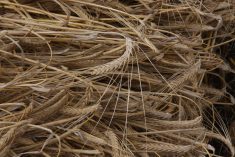An Alberta hog barn company says it is finding fertile financial soils in Saskatchewan, where industry expansion is struggling in a parched environment.
By offering investors hog barn projects that don’t have problems with odor and environmental liability, Pure Lean president Bob Notenbomer said he has been able to break the drought that has beset the hog industry since opposition to new hog barns became a powerful force.
“I don’t think they’re against hog barns,” Notenbomer said about prairie investors.
“I think they’re just against the environmental concerns that come with hog barns.”
Read Also

Vegetable oil stocks are expected to tighten this year
Global vegetable oil stocks are forecast to tighten in the 2025-26 crop year, this should bode well for canola demand.
Notenbomer operates a 5,000 feeder pig operation in Bow Island, Alta., and just opened a 10,000 head feeder barn in Oyen, Alta. His next plan is to expand into Saskatchewan.
His barns are different than most large-scale hog barns because they do not use water to wash manure out of the feeder barns. Instead, the manure lands in sawdust, which is gathered up and composted.
Notenbomer said his system eliminates most of the smell of pig manure and gets rid of lagoons and mucky manure spreading, which greatly increases odor problems.
Notenbomer said this has freed him from obstacles that face other barn proponents.
“We can guarantee zero contamination with this building,” he said.
“No manure will ever touch the ground … around our buildings.”
Dozens of prairie barn proposals have been killed by local opposition from people who fear large-scale hog barns could pollute groundwater and local soils, and who don’t like the smell of pig manure.
Last week, a feeder barn proposed for eastern Manitoba was denied approval because of vociferous local opposition based on water pollution fears.
Notenbomer insists a dry manure treatment system isn’t a flaky idea. He said it can be just as profitable as a water-based system, without the drawbacks.
“It doesn’t make sense to flush manure with water,” he added.
“You just add to the volume. Then you have to transport that liquid and then you have to spread it.”
Notenbomer said his designs don’t use slatted floors, which can cost $3.50 to $4 per square foot. They also don’t use holding tanks and manure lagoons, which are also expensive, nor do they require manure injection trucks.
However, the buildings cost the same because they are larger, at about 12 sq. feet per pig, versus seven to eight sq. feet in a traditional barn.
Clearing the barn of sawdust and manure takes more labor.
University of Saskatchewan bioengineering professor Claude Lague said dry feeder barns are common in Europe, though they are used mainly by small farmers. For centuries all hog farms were based on dry manure storage and treatment, including composting the waste, though no one at the time knew the word “composting.”
Large farms moved to water-based manure handling systems after the Second World War, Lague said, because they require less labor. They also don’t require large supplies of organic material to mix with the manure.
Lague has not studied Notenbomer’s design, but he said the idea of dry manure handling and composting is feasible.
“When you do the math, the numbers come out about the same,” Lague said of the cost of production.
“If you can have access to material for compost and labor and a market for the composted manure, (it can work).”
Notenbomer’s company is now selling the composted manure as Hog Heaven manure. He hopes to build a centralized packaging facility soon.
His company is also trying to convince Medicine Hat, Alta., to process human waste with his system.
Pure Lean raised $3 million from Medicine Hat investors for its $7 million feeder barn near Oyen. Almost none of the money came from farmers.
Notenbomer said the hog industry could find lots of investment capital if it looked beyond rural people and tapped into city investors who see an opportunity without the risks and obstacles they usually associate with the hog industry.
“This is something the consumer has asked for,” Notenbomer said.
“That’s why we’re seeing such interest. It’s no longer driven by the farmers themselves.”
The barns that Pure Lean wants to build in Saskatchewan are all feeder barns. Notenbomer said he would like each to eventually have farrowing barns as well, but they are more expensive. He wants to demonstrate how his system works in a cheaper barn before trying to raise extra money.
“It’s a proof thing,” he said.
“A lot of people don’t believe what they’re hearing and what they’re seeing.”
Each of Pure Lean’s barns is created as a separate company with its own board of directors, though the goal is to one day unite them under Pure Lean’s holding company.
Pure Lean needs $1.5 million to $1.7 million in investor capital for each barn. The rest of the money is borrowed from Farm Credit Corp., which supplies the construction capital, and a bank, which provides the operating line of credit.
Pure Lean intends to raise as much of the $1.7 million as possible from investors, but will make up shortfalls with its own capital, Notenbomer said.
Pure Lean Inc. is listed on the CDNX stock exchange under PYG.

















